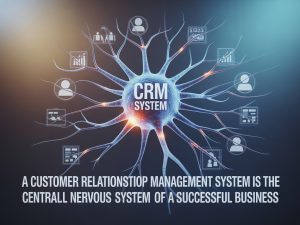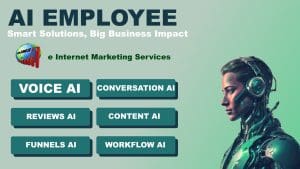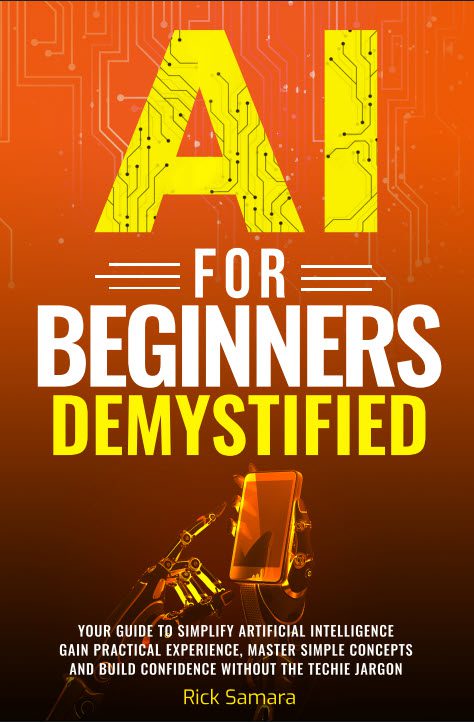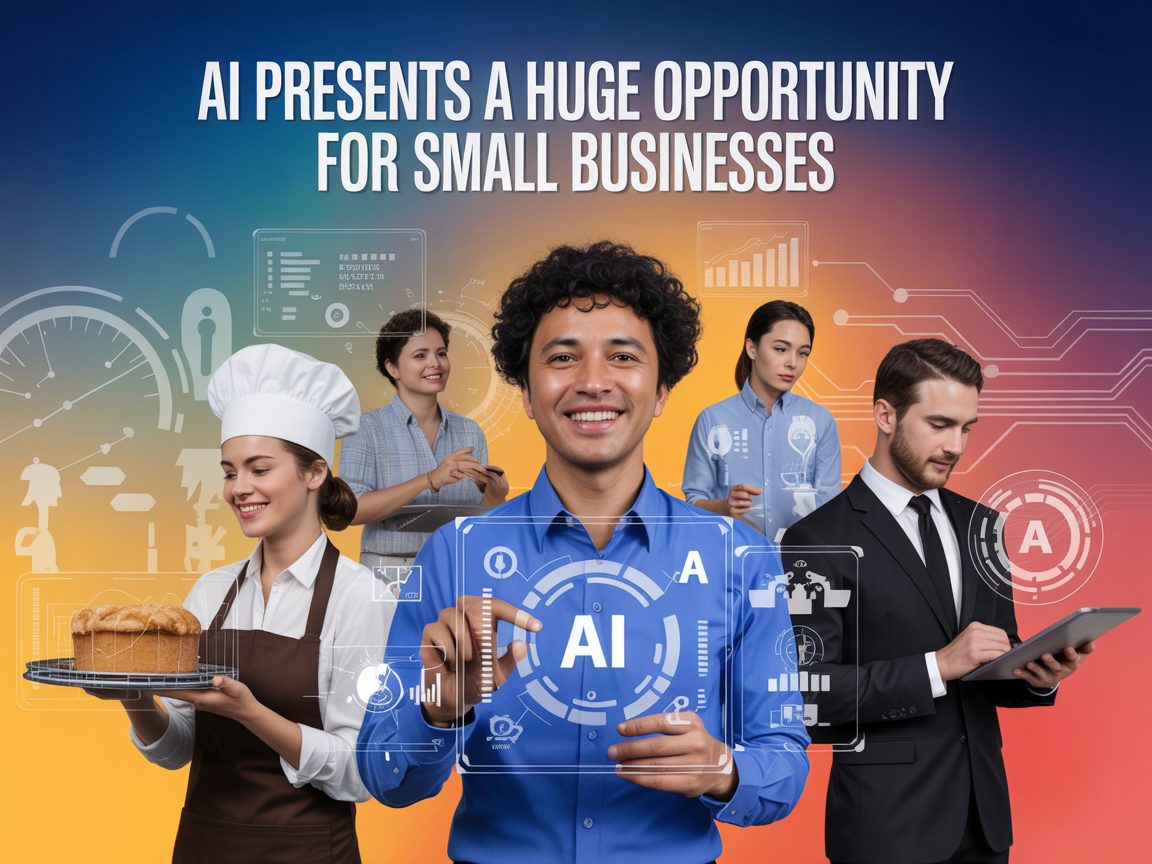AI Presents a Huge Opportunity for Small Businesses Today
Let me explain. Fewer than 15% of small businesses—those with under 50 employees—are using AI tools to boost productivity and grow smarter.¹ That number should be a wake-up call. Because here’s the truth: AI isn’t coming—it’s already here. It’s accessible, affordable, and increasingly essential. And yet, it remains one of the most underused tools in the small business world.
That gap—between what AI can do and what most small businesses think it can do is precisely why I wrote AI for Beginners Demystified. I wanted to demystify common misconceptions about AI and introduce some tools to help you get started with this new technology.
This book isn’t a technical manual or an academic deep dive. It’s a practical, plain-language guide for entrepreneurs and small teams to understand the basics of Artificial Intelligence.
The Misconceptions Holding Business Owners Back
If you run or work in a small business, you’ve probably heard about AI—but maybe you’ve also thought:
-
“Isn’t this stuff just for tech companies?”
-
“Isn’t it too expensive?”
-
“Isn’t it too new and unproven?”
And I get it. These are valid concerns—at least on the surface.
The problem is, they’re primarily based on outdated ideas.
AI has been in the background of our lives for years: powering recommendation engines, spam filters, voice assistants, and more. But the shift—the one that changed everything—happened in late 2022, when OpenAI released ChatGPT to the public.
That was the moment AI became visible. It was the first time people could interact with an advanced language model like they were chatting with another human. For the average person—not just researchers or developers—this was AI with a face.
And it blew the doors wide open.
A Long History, a Fast Acceleration
AI, as a field, has been around for decades. The term “Artificial Intelligence” was coined way back in 1956 at the Dartmouth Conference. Back then, scientists believed machines would soon be able to replicate human intelligence.
Spoiler alert: they were wrong about the timeline. Progress was slower than expected, and for years, AI mainly lived in universities, government labs, and enterprise applications.
But behind the scenes, it kept evolving—quietly powering things like fraud detection, logistics planning, and speech recognition.
Then came 2022. With the public launch of ChatGPT, followed by dozens of other generative AI tools, we crossed a threshold. The tech didn’t just get better—it got easier to use. Suddenly, AI wasn’t abstract anymore. It was something anyone could try for free.
In less than a year, it went from experimental to essential.
The Opportunity for Small Businesses
Here’s the irony: the companies that need AI the most—small businesses—are the ones using it the least. It all begins with a CRM, which acts as the central nervous system for your business.
Within your CRM, AI can: 
-
Draft content in seconds.
-
Generate client emails or proposals.
-
Summarize reports or meetings.
-
Analyze customer trends without a data team.
-
Automate repetitive admin tasks.
And most of this doesn’t require coding or technical know-how: just curiosity and a willingness to try.
So why aren’t more businesses doing it?
The Two Big Myths
Myth #1: “AI is too expensive.”
Not anymore. Most AI tools have free tiers or cost less than $30/month.² That’s cheaper than hiring even one freelancer—and in many cases, faster. These tools, such as ChatGPT and Ideogram, are great for business owners who want to handle everything themselves.
Myth #2: “AI is too new to trust.”
It feels new because tools like ChatGPT are only a few years old. But the technology underneath them is based on decades of research and engineering.³ What’s changed is that it’s now user-friendly and widely available. It’s ready when you are.
Meet AI Employee: A Low-Cost Entry Point for Small Businesses
To make adoption even easier, we offer AI Employee, a guided, low-cost toolkit that brings AI directly into your business without the overwhelm.
Think of it as your first digital hire—ready to handle tedious tasks and give you back your time.
Here’s what’s included:
-
 A Customer Relationship Manager (CRM). This is the central nerve center for your AI Employee. Plus, you get these six handpicked tools you can start using immediately.
A Customer Relationship Manager (CRM). This is the central nerve center for your AI Employee. Plus, you get these six handpicked tools you can start using immediately. -
VoiceAI: A virtual receptionist that responds to every customer phone call and records customer data for follow-up.
-
Conversation AI: This is a chatbot ready to install on your business website. This, along with your Voice AI virtual receptionist, is trained on all aspects of your business.
- Reviews AI: This feature enables you to escape the laborious task of responding to every review. We help you set it up, and it can work autonomously. All Google Reviews should be responded to promptly.
- Content AI: Connect your social media channels, like your Facebook business page, Google Business Profile, and LinkedIn accounts. Use AI to generate a post and an image, then schedule your posts by date and time. Instagram, Threads, Pinterest, YouTube, and TikTok accounts can also be connected.
- Funnels AI: Use the premade templates to create a squeeze or lead capture page. Simply provide something of value, like an offer, in exchange for a name and email address. Grow your marketing list stored in your CRM.
- Workflow AI: Templates for content creation, customized communication, lead generation, and reporting.
-
✅ Step-by-Step Training – Plain-English walkthroughs showing how to set up, customize, and deploy AI in real business tasks.
-
✅ Team Onboarding Resources – So your whole team can start using AI confidently, not just you.
-
✅ Email and Chat Response Templates – Customizable AI-powered scripts for faster customer support and sales outreach.
This isn’t just a course or a theory guide. It’s an action kit. Designed specifically for small teams who don’t have time to experiment but want real results.
Whether you’re a solopreneur or running a 10–50 person company, AI Employee helps you put AI to work now—without hiring developers, consultants, or a whole new team. ChatGPT works in the background, so you don’t need a paid membership for that.
Why I Wrote This Book
I kept seeing small business owners stuck on the sidelines, not because they weren’t innovative or forward-thinking, but because no one had shown them how to get started. And the info that was out there? Overwhelming. Full of jargon. Built for techies, not real people with limited time and resources. I found that most small business owners understand the importance of using AI in their business. They just need someone to walk them through the process and help them set up these crucial tools. That’s what we do at E-Internet Marketing Services.
So I wrote AI for Beginners Demystified to change that.
This book:
-
Explains how AI really works—no hype, no math.
-
Shows which tools are worth your time (and which aren’t).
-
Gives real-world examples from small businesses.
-
Offers easy steps to test, use, and scale AI—without needing a technical team.
It’s not about becoming an AI expert. It’s about using the tools that are already reshaping how business gets things done, and making them work for you.
Why Now?
We’re at a tipping point.
Big businesses are already automating faster, analyzing smarter, and producing content in hours instead of days.
Small businesses can’t afford to wait. But they don’t need to feel intimidated either.
AI won’t replace your job—but someone using AI might outpace your business. The earlier you start learning how to leverage these tools, the more competitive you’ll stay.
AI for Beginners Demystified and AI Employee are your shortcuts to getting ahead.
Final Word
You don’t need to be technical. You don’t need a big budget. You don’t even need to know where to start.
That’s what this book—and this AI Employee toolkit—are for.
The playing field just changed—and small businesses finally have a chance to compete at a whole new level. You just have to pick up the tools. Isn’t it time to find out more about how AI can help your business?
Citations
-
U.S. Chamber of Commerce Technology Engagement Center (2023) – “Small Business and AI Adoption Report”
https://www.uschamber.com/technology/small-business-and-ai -
Gartner Research (2023) – “AI Pricing Models and Cost Trends”
https://www.gartner.com/en/newsroom -
PwC Global AI Study (2023) – “The Macroeconomic Impact of Artificial Intelligence”
https://www.pwc.com/gx/en/issues/analytics/assets/pwc-ai-analysis-sizing-the-prize-report.pdf -
Russell & Norvig, Artificial Intelligence: A Modern Approach – widely cited AI textbook noting AI’s formal launch in 1956 at Dartmouth Conference.
-
OpenAI (2022) – Release notes for ChatGPT.
https://openai.com/blog/chatgpt



